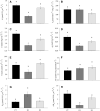Evidence of drought memory in Dipteryx alata indicates differential acclimation of plants to savanna conditions
- PMID: 33020558
- PMCID: PMC7536413
- DOI: 10.1038/s41598-020-73423-3
Evidence of drought memory in Dipteryx alata indicates differential acclimation of plants to savanna conditions
Abstract
The remarkable phytogeographic characteristics of the Brazilian savanna (Cerrado) resulted in a vegetation domain composed of plants with high structural and functional diversity to tolerate climate extremes. Here we used a key Cerrado species (Dipteryx alata) to evaluate if species of this domain present a mechanism of stress memory, responding more quickly and efficiently when exposed to recurrent drought episodes. The exposure of D. alata seedlings to drought resulted in several changes, mainly in physiological and biochemical traits, and these changes differed substantially when the water deficit was imposed as an isolated event or when the plants were subjected to drought cycles, suggesting the existence of a drought memory mechanism. Plants submitted to recurrent drought events were able to maintain essential processes for plant survival when compared to those submitted to drought for the first time. This differential acclimation to drought was the result of orchestrated changes in several metabolic pathways, involving differential carbon allocation for defense responses and the reprogramming and coordination of primary, secondary and antioxidant metabolism. The stress memory in D. alata is probably linked the evolutionary history of the species and reflects the environment in which it evolved.
Conflict of interest statement
The authors declare no competing interests.
Figures










References
-
- Lapola DM, et al. A climate-change vulnerability and adaptation assessment for Brazil’s protected areas. Conserv. Biol. 2019;0:1–11. - PubMed
-
- Dalle Laste KC, Durigan G, Andersen AN. Biodiversity responses to land-use and restoration in a global biodiversity hotspot: Ant communities in Brazilian Cerrado. Austral Ecol. 2019;44:313–326. doi: 10.1111/aec.12676. - DOI
-
- Ab’Saber AN. Spaces occupied by the expansion of dry climates in South America during the quaternary ice ages. Rev. Inst. Geol. 2000;21:71–78.
-
- Neves G. A chuva no estado de Goiás e Distrito Federal: Aspectos espaciais, temporais e dinâmicos. Rev. Bras. Climatol. 2019;8642:67–82.
Publication types
MeSH terms
Substances
LinkOut - more resources
Full Text Sources

